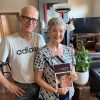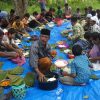A Central Java village has been revitalised by sustainable, socially responsible design
Jessica Lea Dunn
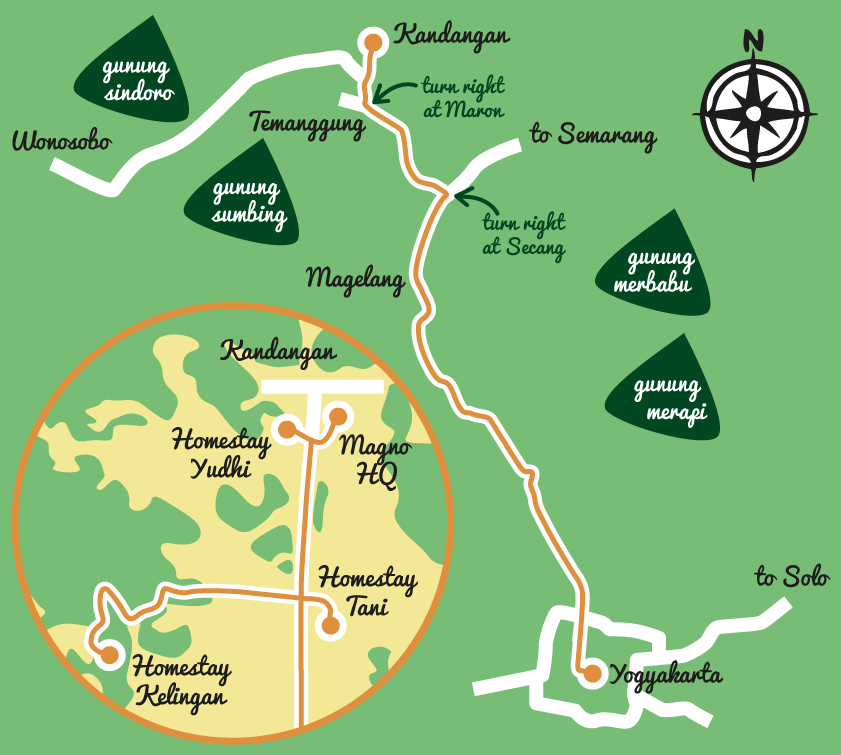 Map of Kandangan and surrounding area. Illustration by Jessica Lea Dunn
Map of Kandangan and surrounding area. Illustration by Jessica Lea Dunn
Nestled amongst a lush bamboo garden in the Javanese village Kandangan is the extraordinary home and studio of product design legend, Singgih Kartono, creator of the international award-winning Magno wooden radio. Alongside the designer’s residence is the workshop and factory where the magic takes place – slabs of wood are cut, shaped, sanded and assembled to create high-end, hand-made craft objects with such perfect proportions that they almost could have been made by machine. For eco-design aficionados across Indonesia and internationally, the Magno company and its sister projects in Kandangan village are excellent examples of how sustainable, socially responsible product design can generate new business models for villages. When the focus in the design process shifts from mass production to direct community benefit, all kinds of transformations are possible.
The Magno radio
The story of Singgih Kartono and Magno is as unique as the quirky radio itself. The brand name ‘Magno’ comes from magnifying glass, which happened to be the first wooden product to be produced by the company, and became a symbol of the company’s attention to design detail. Kartono began his company after graduating from the Bandung Institute of Technology (ITB) with a major in Product Design. Noticing an acute deterioration of Kandangan’s agricultural sector and village life, he returned to his community to use his knowledge, skills and experience to rebuild the village potential with craft-based manufacturing output.
Singgih Kartono never intended to create a design icon with his radio made from rosewood and East Indian pine – but that’s exactly what he did. Conceived as a “Craft Radio” prototype in the mid-1990s—Kartono’s graduating project from ITB—the refined Ikono design was eventually launched 10 years later after an initial struggle to obtain a regular supplier of the internal electronic components. In a world filled with mass-produced metal and plastic electronic products, the design of Magno was viewed as a refreshing response – inspiring a reaction across the internet with its surprising combination of materials, form and end use. Using a wooden casing to house an electronic product is actually an historical idea—if we look back to the radio cabinets of the past when the technology was first commercialised and then to the stereo systems of the 1970s and 1980s covered in wood veneer—but this was a new innovation to make the wooden radio into a contemporary product with a minimalist, modern, almost ‘Scandinavian’ form.
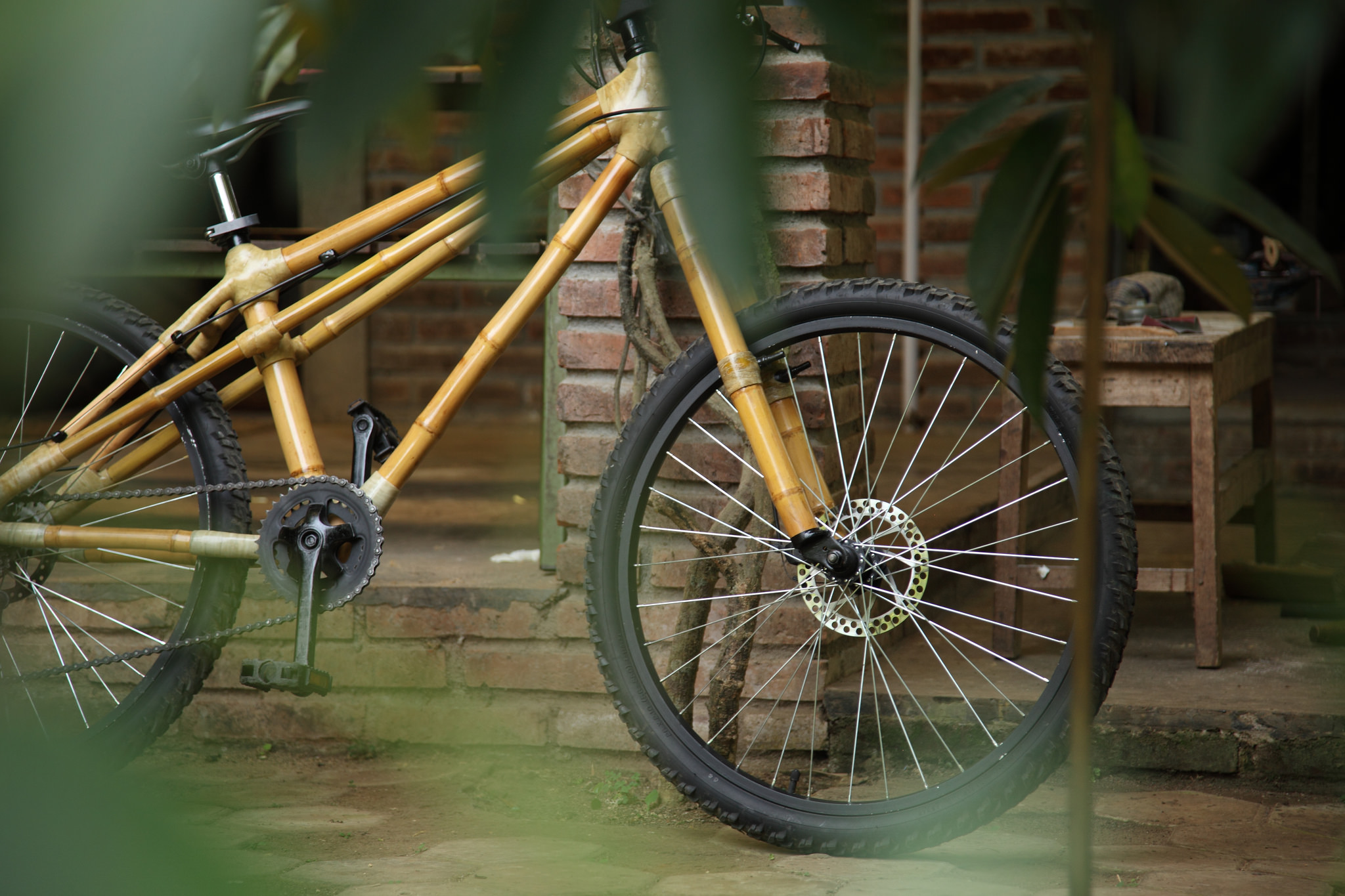 The Spedagi bamboo bicycle.
The Spedagi bamboo bicycle.
Kartono was successful in taking wood, traditionally seen as low-tech and used for larger-scale objects, and counter-intuitively matching the material with the relatively high-tech function of receiving and broadcasting sound. The result was the elegant, minimalist aesthetic of the original Ikono radio that continues to enrapture design lovers around the globe – the model is still the number one best seller for Magno, despite the subsequent launch of many new products.
Unlike many Indonesian wood products, Magno’s are unvarnished. Instead they are lightly polished with wood oil which maintains the surface shine, highlights the wood grain and enhances its natural colour. The owner of any Magno radio will also need to give it the occasional polish to maintain the surface. This is an integral part of a design philosophy that rejects mass consumption and throwaway culture in favour of conscious consumption and creating modern heirlooms for the end user to treasure.
For Singgih Kartono, the design philosophy behind the product is just as important as the physical object. It was a conscious philosophical choice for Magno, which now employs around 30 people, to produce small craft products only – the key is in the ratio of value added per amount of material used. By creating small, high value, functional items, much in the same way that the Swiss created watches, the environmental impact is vastly reduced, while the potential for positive human impact is increased. In this case, a relatively inexpensive material—wood—is treated as a precious resource which requires the investment of human resources—skill, labour and time— to create something special, resulting in many jobs being created for very little wood used.
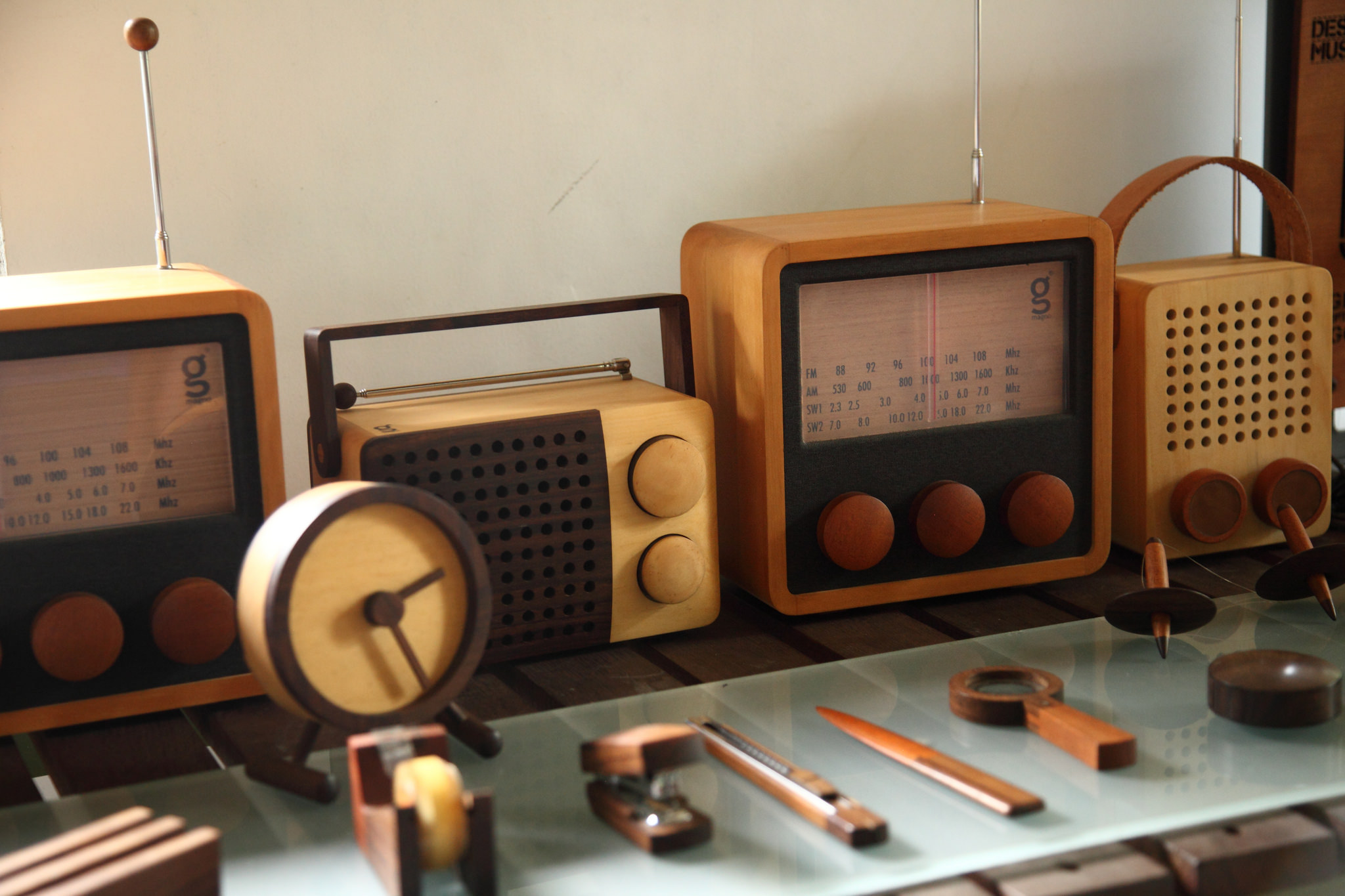 Magno’s product range on display at the workshop in Temanggung
Magno’s product range on display at the workshop in Temanggung
In contrast, Kartono regards furniture as a high wastage product that requires the use of a lot of natural material per product created. With forestry management in Indonesia still lacking transparency, and the first IKEA having just opened in Jakarta unlikely to be the last, Kartono believes furniture construction is an unsustainable use of resources in a village context. On the other hand, the Magno factory uses the equivalent of just two large trees per year to create their entire range of small wooden products. They also have a reforestation scheme, where each year almost 50 trees, of the same type used in making Magno craft products, are donated to local farmers, thereby generating a net positive effect.
Other positive impacts include building the overall skill capacity of individuals within the Kandangan community. Magno operates within a framework of the New Craft methodology, whereby the products are still hand-made and classified as handicraft, but are produced using modern principles of manufacturing management. This means that the designs are specified, production manuals are written and the methods followed step by step, so that individuals or even whole villages with no prior experience in craft can be easily and quickly trained, and that the resulting products are of a standard form and quality.
Despite having a standard appearance, every radio is unique, with a slightly different wood grain to the next, and every battery cover is shaped to exactly fit the radio for which it is intended. Parts cannot be interchanged. It is through this attention to detail and precision construction that we know the product is made with the highest quality craftsmanship.
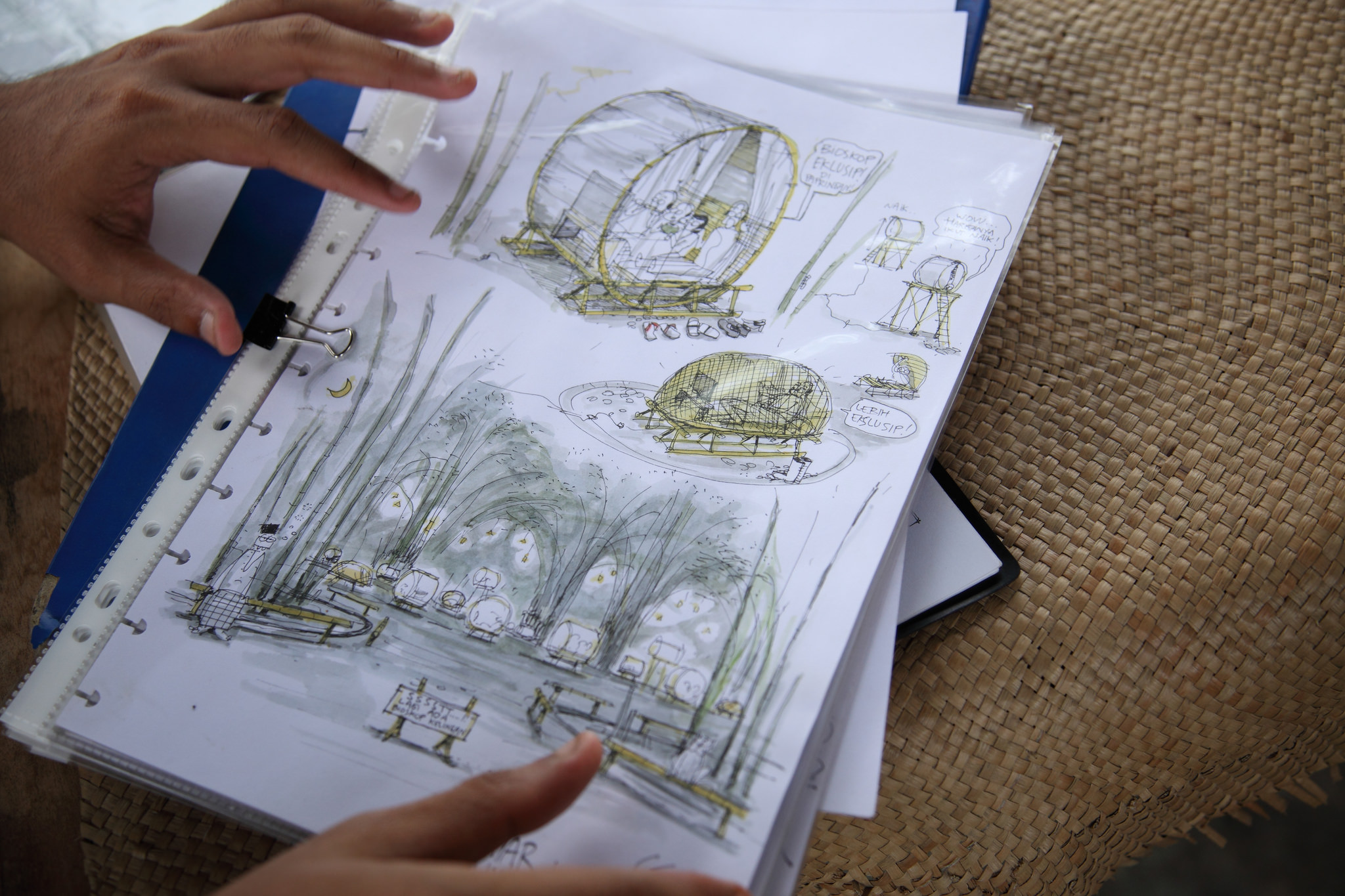 An early drawings made by the architect Errik Irwan Wibowo for a two-story homestay bungalow
An early drawings made by the architect Errik Irwan Wibowo for a two-story homestay bungalow
There’s no computer aided manufacturing (CAM) setup in this workshop, no computer controlled cutting machines (CNC routers) that can automatically fashion out a shape. At Magno, each product is created by human labour; each hole in the radio grill created one by one with a hand press drill and each radio facade sanded to the perfect curvature by a skilled craftsperson. While the international trend is to move towards automated mass manufacture wherever possible, in the Javanese village setting, a labour intensive craft-based manufacturing process – when implemented correctly – is still the perfect fit. It creates jobs, lifts the specialised skill level of the community, and therefore increases the wealth and wellbeing of not only a few individuals or a company, but of many local people.
Spedagi – the bamboo bicycle and rural homestay
In recent years, Kartono’s focus has been branching out into systems design, sustainable tourism, homestay guest houses, professional and student volunteer collaborations and organic farming. A recent addition to the factory product line is a bamboo bicycle called ‘Spedagi’, a shortened form of ‘Sepeda Pagi’, named after a local tradition of going about one’s business in the early morning by bicycle.
The bamboo bicycle was created to be a conversation-starter about a sustainable design movement. While of course it is still a real product made by Indonesians for the local market, the purpose was never to focus solely on production of bamboo bicycles – there are many international companies already making bicycles out of alternative materials. The Spedagi is a way of showcasing local Indonesian design potential that doesn’t rely on the export market for economic survival – as is mostly the case with Magno wooden products. Kartono’s intentions also link to eco-tourism ambitions for the village. It is hoped that the bamboo bicycle acts as a magnet to draw people to the village, inviting curiosity, as well as being a handy method of transportation for visitors and volunteers who stay in the guesthouses.
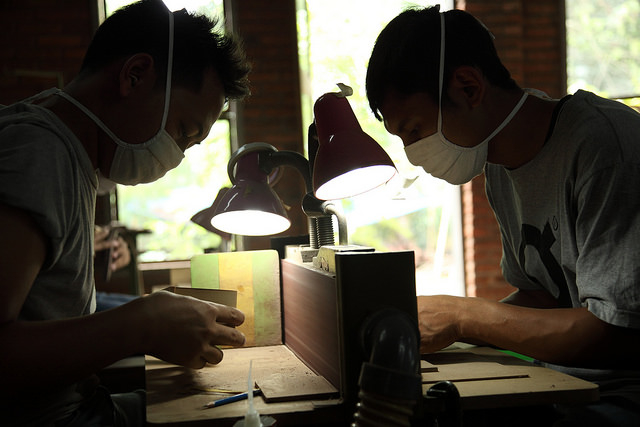 The Magno radio factory workshop is well ventilated and filled with natural sunlight
The Magno radio factory workshop is well ventilated and filled with natural sunlight
Hopping on a bamboo bicycle is the best way to travel the short distance between the Spedagi guesthouses in Kandangan. These architect-designed wooden and bamboo constructions are dotted around the local area, along the fringes of existing residential settlements and backing onto vast rice fields. Those who stay are expected to lend their creative talent and leave a lasting impact in the form of village improvement projects, as well as having the opportunity to explore local natural materials such as wood, bamboo and palm leaf; learn building and construction techniques; and study traditional farming practices from the local residents. Kartono hopes that in the future it will be not only architects and product designers who are attracted to come to work together on co-design projects, but also experts and students from marketing and business management disciplines who also come to collaborate and help develop creative solutions for livelihood creation and revitalisation projects.
Architectural co-design: coffee plantation cocoons
One of the most exciting co-design projects under the Spedagi umbrella has been the creation of cocoon sleeping pods that look like they have been spun by giant insects amongst the coffee trees. The site is located on an existing coffee plantation adjoining the village of Kelingan, not far from Kandangan. A collaboration between Kartono, Errik Irwan Wibowo (architect) and Muslih Nu (cabinet maker and wood specialist), as well as many local builders, landowners and volunteers, these cocoon pods are intended to demonstrate liveable architectural structures that complement the surrounding environment. In creating these types of projects, an informal process of co-design between the architect/designer and the local stakeholders takes place – one that usually involves brainstorming and sketching ideas over coffee in a street-side food stall well into the night. The rich discussion, the friendship, and a sense of ownership over the concepts generated by the design process are just as important as the design concepts themselves. The end result of adopting a collaborative approach can be quite extraordinary, just as these human cocoons are both original and sensitive to local needs. The physical artefact of the cocoon is a visual reminder of the creative potential present in the wider community, waiting to be released if incubated under the right conditions. For it is not only the trained design professional who has valuable ideas, though they do have the potential to be catalysts for change.
Bringing communities and professionals together to cultivate change and envision positive scenarios for the sustainable village life of the future was the intention of The 1st International Conference on Village Revitalization. Held in March 2014 in a giant temporary tent amphitheatre in the middle of a bamboo grove in Kelingan, the forest space was converted into a lush green badminton court after the conference. Months later, the only evidence that remained of the event venue were photos on the architect’s cell phone that show the magical, almost ethereal effect of the white parachute fabric tent amongst a sea of emerald bamboo stalks. By June 2014, co-created proposals for future uses of the space had evolved to include ideas of designing multi-functional outdoor furniture that could be used for pop-up markets, meeting spaces, as well as moonlight cinema seating.
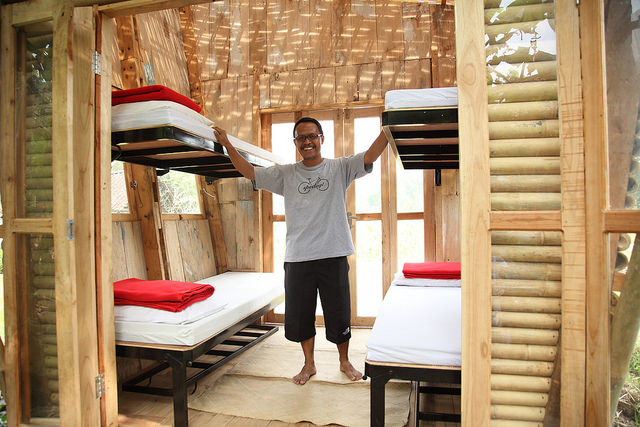 A Spedagi homestay bungalow, built entirely from locally available wood and bamboo, sleeps 4-5 people in bunk beds that fold up against the wall to create space during the day
A Spedagi homestay bungalow, built entirely from locally available wood and bamboo, sleeps 4-5 people in bunk beds that fold up against the wall to create space during the day
In executing any of these concepts, the architect must embrace many roles, at times becoming a furniture designer, while at others becoming the events co-coordinator, project manager, anthropologist or consultant. The cross-over between design disciplines is a fluid and natural evolution of the creative professional working in such a local collaborative context. In much the same way, Singgih Kartono’s work and life passion has evolved from a product design practice into a multi-disciplinary, collaborative, entrepreneurial practice spanning everything from unique architectural concepts, to organic farming practice, eco-sustainable and socially-responsible ‘tourism’, systems design, and new business model generation. With a shift in design focus to addressing real needs, the creation of new products is able to complement the rest of the holistic multidisciplinary design practice that occurs, and in so doing, an entire village community can reap the benefits.
Jessica Lea Dunn (jessdunnthis@gmail.com) is a Sydney based designer with a passion for Indonesia and socially responsible design. She was briefly famous when her graduating project, a folding motorcycle helmet easily carried in a backpack inspired by her time in Indonesia, went viral online. Her other Indonesia-themed projects include creating playground equipment and dining hall furniture for Olifant preschool in Yogyakarta, and designing bags and accessories from recycled plastic packaging for XSProject in Jakarta.





